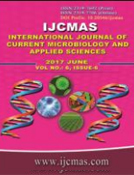


 National Academy of Agricultural Sciences (NAAS)
National Academy of Agricultural Sciences (NAAS)

|
PRINT ISSN : 2319-7692
Online ISSN : 2319-7706 Issues : 12 per year Publisher : Excellent Publishers Email : editorijcmas@gmail.com / submit@ijcmas.com Editor-in-chief: Dr.M.Prakash Index Copernicus ICV 2018: 95.39 NAAS RATING 2020: 5.38 |
This prospective study was conducted in our tertiary care set up to detect the bacterial isolates with antibiotic susceptibility pattern from pus samples, along with sociodemographic factors leading to wound infections and mainly to provide relevant data of antibiotics preferred for each bacterial isolate. This would be a baseline for formulation of necessary policies for antibiotic use in our set up. In our study almost 1836 (75%) of pus samples showed bacterial growth. 1303 (71%) male patients were infected whereas only 533(29%) female patients were infected. Common age group involved is 21–40 years. Gram negative bacteria were isolated more than gram positive bacteria. Out of which Klebsiella species was the most predominant bacterial pathogen 635(35%) followed by Staphylococcus aureus 334 (18%), Escherichia coli 253 (14%), Coagulase negative Staphylococcus species 204 (11%), Pseudomonas aeruginosa 153 (8%), Proteus species 126 (7%), Citrobacter species 51 (3%), Enterococcus species 43(2%) and Acinetobacter species 37 (2%). Highest incidence was due to ESBL isolates of Pseudomona aeruginosa 90 (59%) followed by Klebsiella sp 312(49%), E. coli 124 (49%), Proteus sp. 62(49%), Acinetobacter sp 18 (48%) and Citrobacter sp 18 (35%).MRSA isolates were 96(43%) in Staphylococcus aureus isolates followed by 84(41%) in Coagulase negative Staphylococcal species.
 |
 |
 |
 |
 |